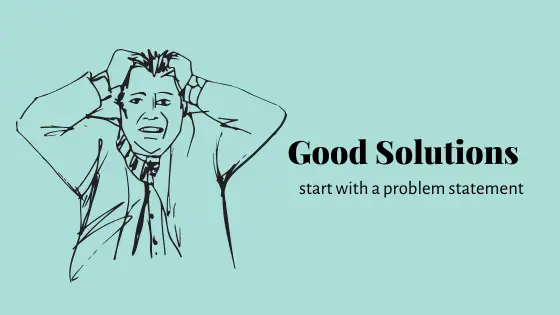How many times have you started to design a solution only to discover in hindsight that you were going down the wrong path?
We need to become better at asking the right questions in the beginning. Good solutions require a good understanding of the problem – which is a relevant step I often see skipped or rushed through when it comes to UX design.
“If I had an hour to solve a problem I’d spend 55 minutes thinking about the problem and 5 minutes thinking about solutions.”
Albert Einstein
What is a problem statement?
A problem statement identifies the gap between the current state (i.e. the problem) and the desired state (i.e. the goal) of a process or product.
We need to be clear about the gap. I see a lot of problem statements who focus either on the current state (“We have too many customers calling in to track their package/ delivery process.”) or on the future state (“We want to increase our customer interaction on Facebook messenger.”), but rarely include both.
Take some time to clearly understand the current situation or behaviour and to get clear on your ideal vision, the goal, so you can provide your team with a better understanding of what they need to solve.
What makes a good problem statement for UX Design?
You can phrase your problem from two different perspectives: from the business side (what is the ideal customer behaviour that would help us strive) or from the customer side (what are thee needs and expectations that we need to meet).
Business: “As an online shop our call center is overwhelmed by customer calls related to delivery tracking which results in overworked staff and unhappy customers due to long waiting times.”
Customer: “As a customer I am disappointed and unsatisfied if my online order takes longer than what was promised and if I don’t receive any information about timing at all.”
Try to include the 4 Ws in your problem statement:
- Who is having the problem?
- What are they struggling with?
- Where does the problem occur?
- Why is it a pain point?
In product and service design it is relevant to look at both perspectives, the business and the customer pain points, to create a solution that is beneficial for both.
How do you write a meaningful problem statement?
The key ingredient is a good understanding of your current situation.
- Be clear on the pain point: Define the problem – what exactly is causing an issue and WHY is it an issue.
- Discover the cause: Find out why the current situation/ the current behaviour occurs – what is triggering the problematic situation or what is blocking a situation from being ideal?
- Use the 5 Whys technique: Drill down to the root cause by asking “Why” multiple times.
Here are some techniques and tools that will help you to discover the causes:
- Data Analytics: What does the data tell you about your customer behaviour?
- Social Media and Customer Service: Are customers sharing anything about their pain points and frustrations
- Competitive Analysis: Are there any obvious solutions from your competitors that work better than yours?
- Customer interviews: talking to your customers and observe their behaviour will provide the best in-depth knowledge about an existing pain point.
Make sure you understand the causes (the Why) that lead to your pain point so you can come up with an effective solution.
What comes after the problem statement?
Once you are clear about the pain points of your current situation as well as the key aspects of your ideal (future) situation, you can move to the ideation phase: gather as many ideas as possible taht will help you to solve your problem.
The clearer your problem statement is,
- the easier it will be for you to communicate it to your team (so they can support you with ideas),
- and the better it serves as a guideline to evaluate your ideas and to make sure you are moving into the right direction.
For further reading: Inputs for ideation techniques.
